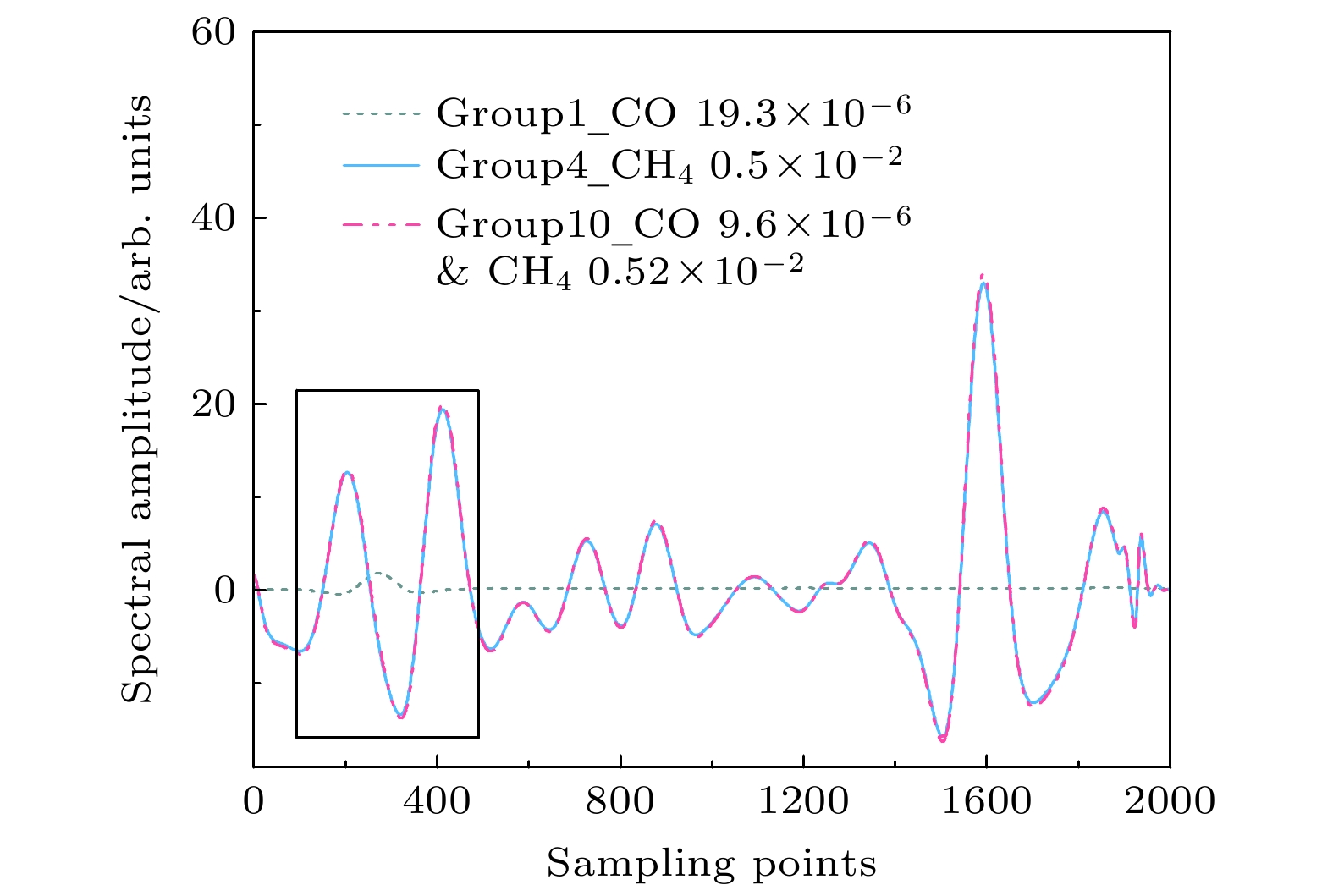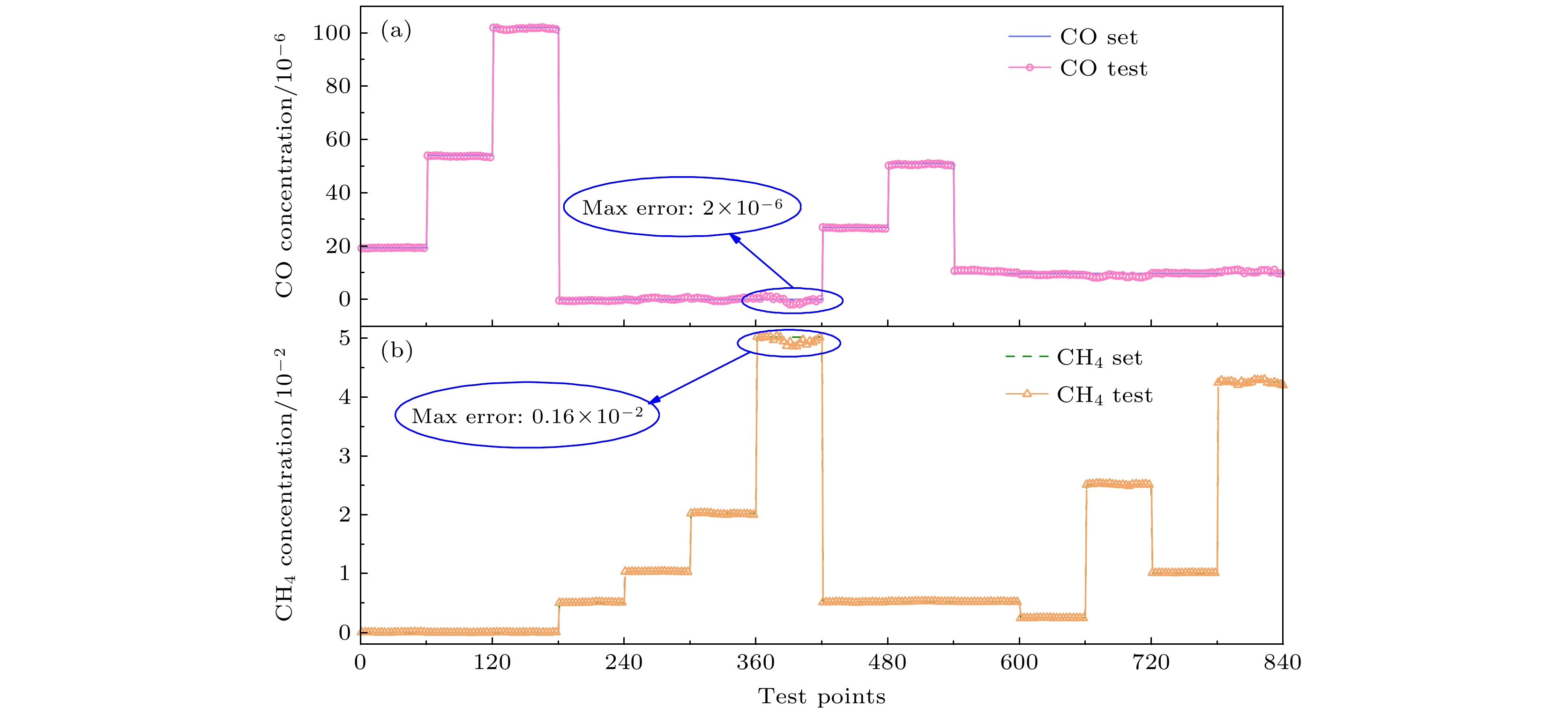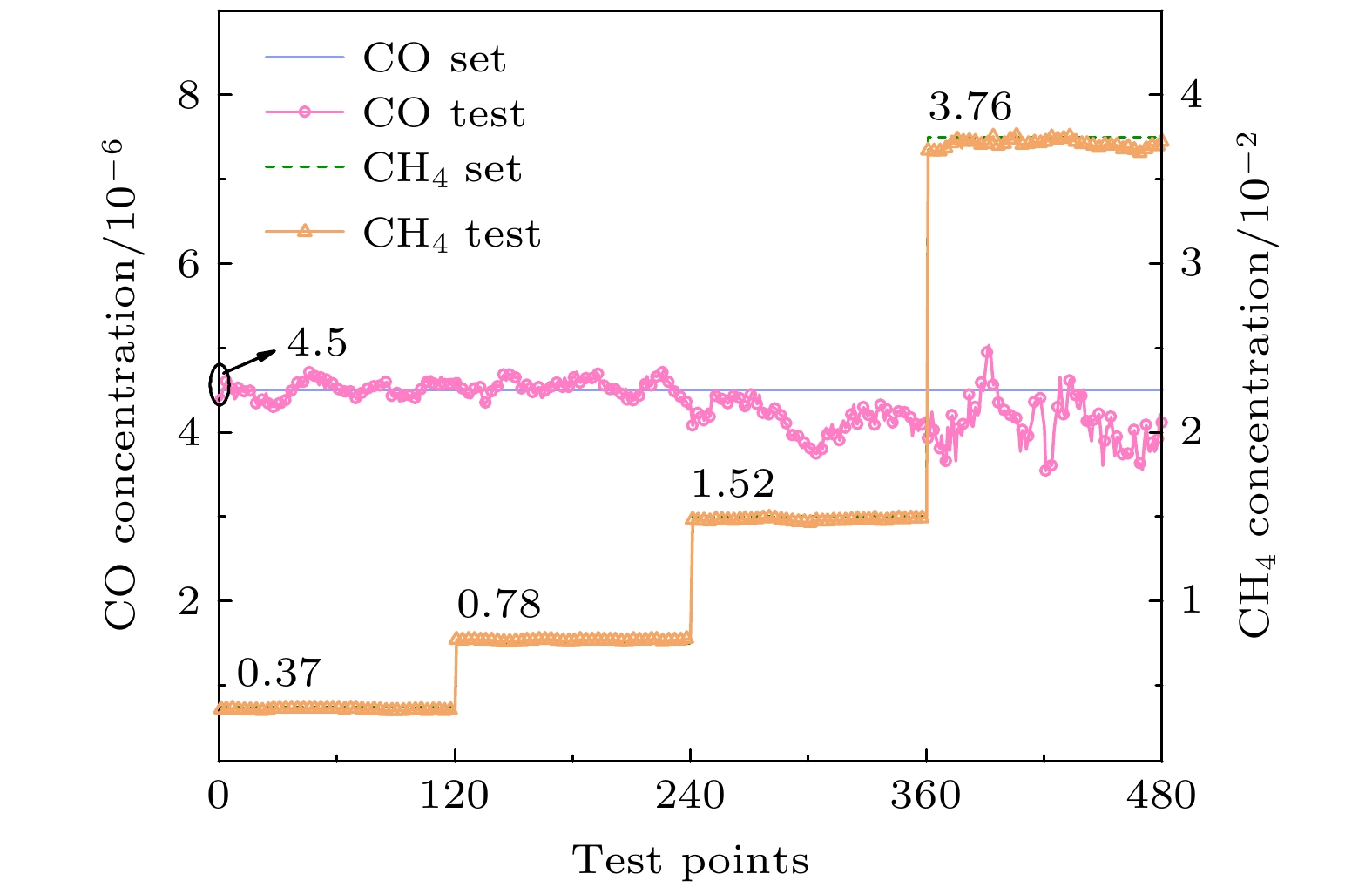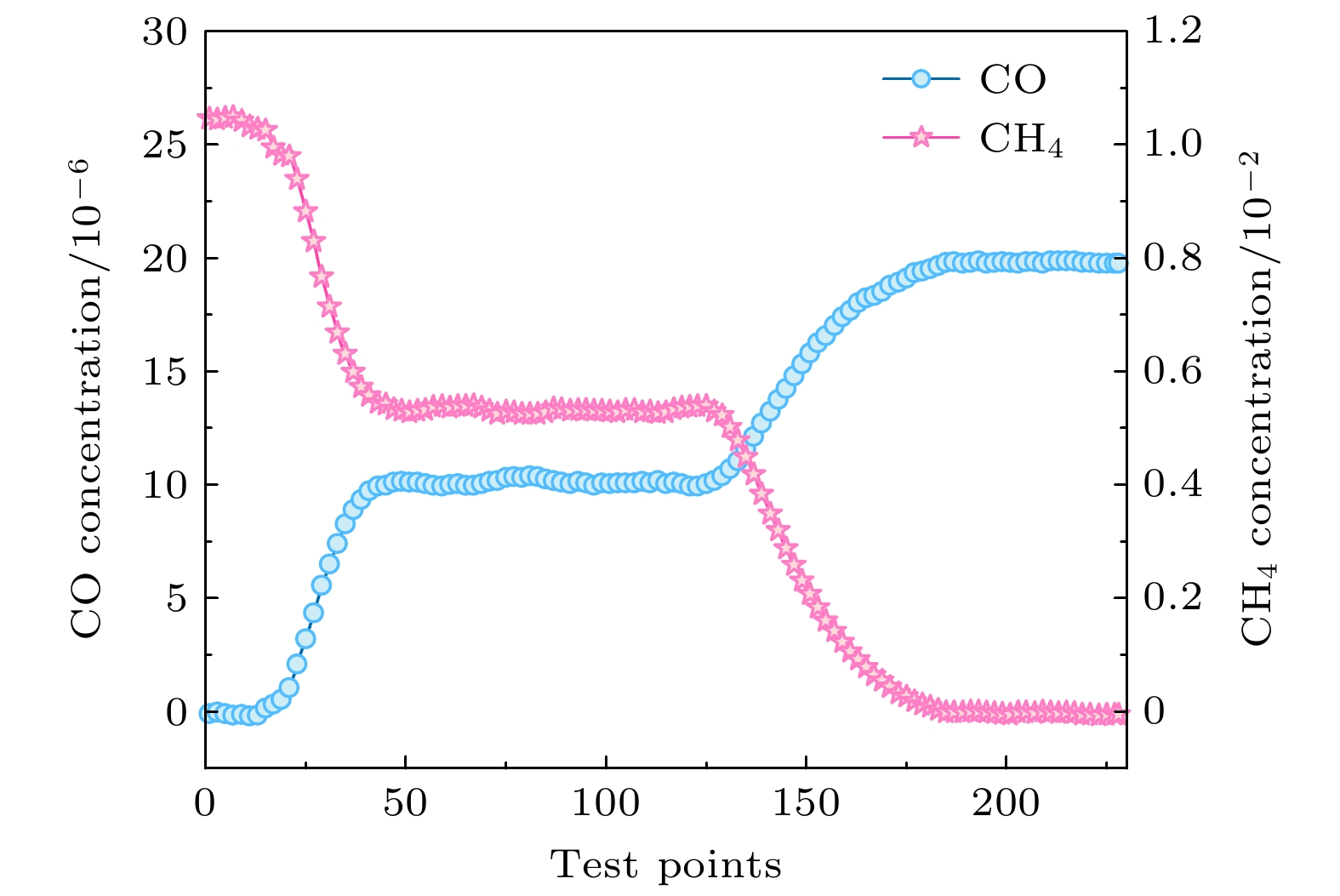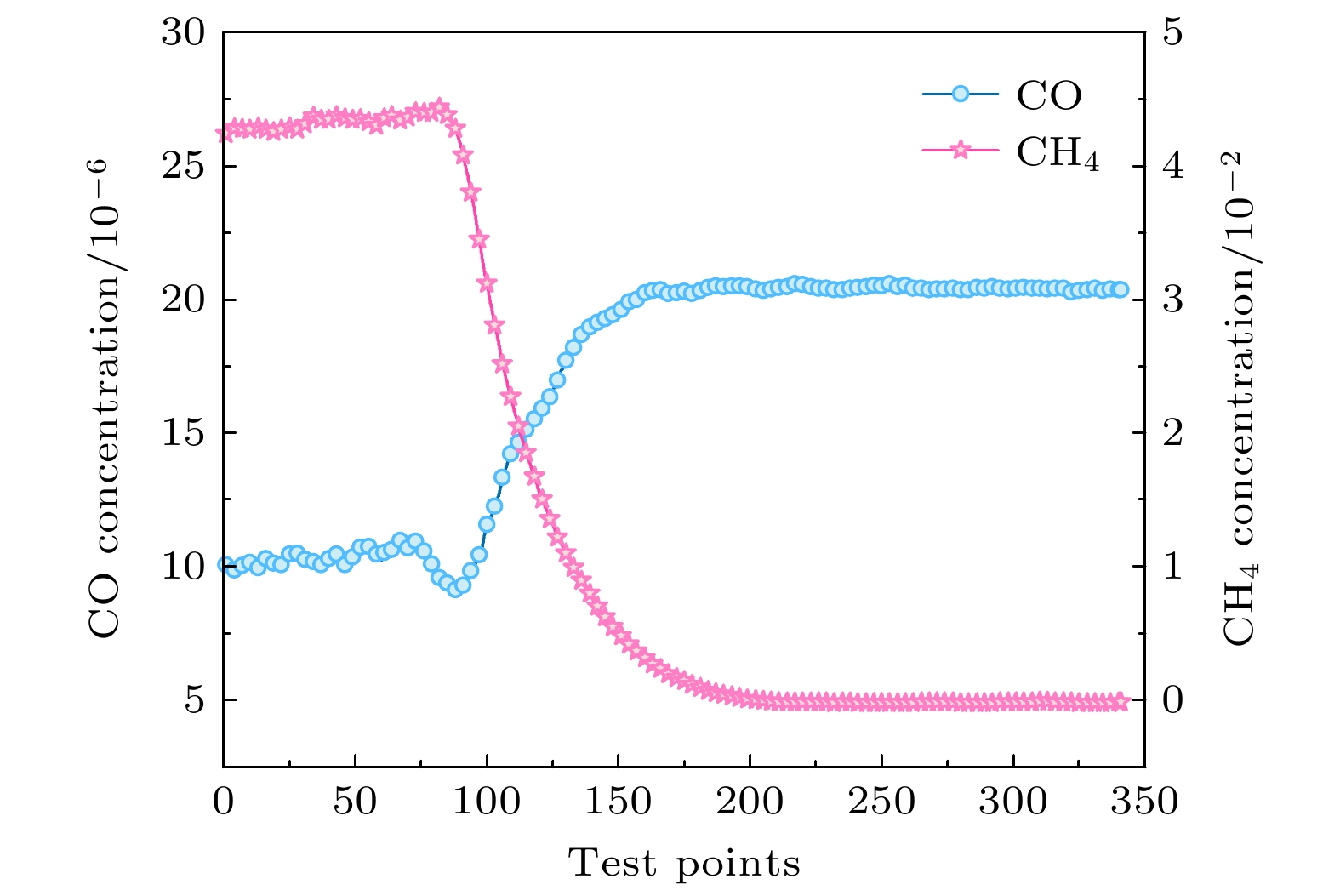-
在基于可调谐二极管激光吸收光谱技术(tunable diode laser absorption spectroscopy, TDLAS)进行多种组分混合气体测量时, 经常会遇到吸收谱线之间存在相互干扰的现象, 这也是使用该技术测量过程中的主要“瓶颈”. 比如在前期的应用中: 微量一氧化碳(CO)和甲烷气体(CH4)在同时检测时两者的吸收谱线存在严重的重叠干扰现象, 特别是在高浓度CH4存在的环境下, 微量CO气体吸收信号会被干扰甚至湮没, 无法实现有效解调, 这是通过谱线选取所不能解决的问题. 因此, 针对此问题本文提出了基于支持向量回归模型, 以CO和CH4吸收谱线的严重重叠干扰问题为例, 通过选择线性核函数建立CO支持向量回归模型和CH4支持向量回归模型, 可对CO和CH4的混合气体吸收谱线进行解调, 最终获得两种气体浓度的准确测量结果. 通过实验分别实现了四种不同浓度CH4环境下微量CO气体的检测, 得到的CO和CH4浓度(气体的体积分数)测量的绝对误差分别小于2 × 10–6和0.2 × 10–2; 通过不同浓度的固定配比实验分析, CO和CH4气体的测量值与实际值之间的相关系数分别达到了0.998和0.9995, 且CO和CH4气体测量结果的绝对误差分别不超过2 × 10–6和0.1 × 10–2, 完全满足了混合气体的精确测量, 为实现多场合混合气体目标的实时监测提出了解决方案.
-
关键词:
- 可调谐二极管激光吸收光谱 /
- 混合气体 /
- 谱线重叠 /
- 支持向量回归
The interference between overlapping gas absorption lines often occurs in the measurement of multi-component gas mixture with using tunable diode laser absorption spectroscopy (TDLAS). This is also the main problem of the technology in some applications. For instance, in the early application of multi-component gas mixture measurement in coal mines, we found that the absorption lines of carbon monoxide (CO) and methane (CH4) seriously overlapped. The absorption signal of trace CO gas was annihilated and could not be effectively demodulated, especially in the presence of high concentration of CH4. This problem could not be solved just by accurately selecting the spectral lines due to the band absorption of CH4. Therefore, in this paper, we introduce the support vector regression (SVR) model to deal with the interference between CO and CH4 absorption lines. The spectral signals of 14 groups of mixed gases with different concentrations of CO and CH4 are used as the training sets, and the five-fold cross-validation is adopted to prevent the model from overfitting. After 15 iterations in 30 seconds, the optimal regression model of CO and CH4 can be obtained respectively. Furthermore, it is worth noting that based on the experimental data, the linear kernel function is selected to construct the two gas SVR models, and the parameters of the SVR models are optimized by the sequential minimal optimization(SMO) algorithm. With the assistance of the SVR models, the absorption spectra of the two gases can be demodulated effectively, and finally the accurate measurement results are obtained. The measurement results show that the absolute error of trace CO and CH4 concentration(volume fraction of gas) are less than 2 × 10–6 and 0.2 × 10–2 respectively. Meanwhile, the correlation coefficient between the measured values and the actual values of CO and CH4 are 0.998 and 0.9995, respectively. In addition, the dynamic stability for each of the two regression models is fully verified by the experiment of the inflation process. Consequently, this method can eliminate the interference between the overlapping spectra, and can fully meet the requirements for accurately measuring the gas mixture. We hope that the SVR model can provide an effective solution for the real-time monitoring of multi-component gas mixture, and thus greatly improving the adaptability of TDLAS technology in the future.-
Keywords:
- tunable diode laser absorption spectroscopy (TDLAS) /
- gas mixture /
- overlapping spectral lines /
- support vector regression
[1] Zhang Z R, Pang T, Yang Y, Xia H, Cui X J, Sun P S, Wu B, Wang Y, Sigrist M W, Dong F Z 2016 Opt. Express 24 A943
 Google Scholar
Google Scholar
[2] Wang F P, Chang J, Wang Q, Wei W, Qin Z G 2017 Sens. Actuators A 259 152
 Google Scholar
Google Scholar
[3] Avetisov V, Bjoroey O, Wang J, Geiser P, Paulsen K G 2019 Sensors 19 5313
 Google Scholar
Google Scholar
[4] Nwaboh J A, Werhahn O, Ortwein P, Schiel D, Ebert V 2013 Meas. Sci. Technol. 24 015202
 Google Scholar
Google Scholar
[5] Vallon R, Soutade J, Verant J L, Meyers J, Paris S, Mohamed A 2010 Sensors 10 6081
 Google Scholar
Google Scholar
[6] 夏滑, 吴边, 张志荣, 庞涛, 董凤忠, 王煜 2013 物理学报 62 214208
 Google Scholar
Google Scholar
Xia H, Wu B, Zhang Z R, Pang T, Dong F Z, Wang Y 2013 Acta Phys. Sin. 62 214208
 Google Scholar
Google Scholar
[7] Zhang L W, Zhang Z R, Sun P S, Pang T, Xia H, Cui X J, Guo Q, Sigrist M W, Shu C M, Shu Z F 2020 Spectrochim. Acta, Part A 239 118495
 Google Scholar
Google Scholar
[8] He Q X, Dang P P, Liu Z W, Zheng C T, Wang Y D 2017 Opt. Quantum Electron. 49 115
 Google Scholar
Google Scholar
[9] Kluczynski P, Gustafsson J, Lindberg A M, Axner O 2001 Spectrochim. Acta, Part B 56 1277
 Google Scholar
Google Scholar
[10] Wang F, Wu Q, Huang Q X, Zhang H D, Yan J H, Cen K F 2015 Opt. Commun. 346 53
 Google Scholar
Google Scholar
[11] Lin X, Yu X L, Li F, Zhang S H, Xin J G, Chang X Y 2013 Appl. Phys. B: Lasers Opt. 110 401
 Google Scholar
Google Scholar
[12] Köhring M, Huang S, Jahjah M, Jiang W, Ren W, Willer U, Caneba C, Yang L, Nagrath D, Schade W, Tittel F K 2014 Appl. Phys. B 117 445
 Google Scholar
Google Scholar
[13] Zhang T, Kang J, Meng D, Wang H, Mu Z, Zhou M, Zhang X, Chen C 2018 Sensors 18 4295
 Google Scholar
Google Scholar
[14] 张志荣, 吴边, 夏滑, 庞涛, 王高旋, 孙鹏帅, 董凤忠, 王煜 2013 物理学报 62 234204
 Google Scholar
Google Scholar
Zhang Z R, Wu B, Xia H, Pang T, Wang G X, Sun P S, Dong F Z, Wang Y 2013 Acta Phys. Sin. 62 234204
 Google Scholar
Google Scholar
[15] Gabrysch M, Corsi C, Pavone F S, Inguscio M 1997 Appl. Phys. B 65 75
 Google Scholar
Google Scholar
[16] Cai T D, Gao G Z, Wang M R 2016 Opt. Express 24 859
 Google Scholar
Google Scholar
[17] Malegori C, Marques E J N, Freitas S T d, Pimentel M F, Pasquini C, Casiraghi E 2017 Talanta 165 112
 Google Scholar
Google Scholar
[18] 张志荣, 夏滑, 董凤忠, 庞涛, 吴边 2013 光学精密工程 21 2771
 Google Scholar
Google Scholar
Zhang Z R, Xia H, Dong F Z, Pang T, Wu B 2013 Opt. Precis. Eng. 21 2771
 Google Scholar
Google Scholar
[19] Shao L G, Fang B, Zheng F, Qiu X B, He Q S, Wei J L, Li C L, Zhao W X 2019 Spectrochim. Acta, Part A 222 117118
 Google Scholar
Google Scholar
[20] Qu J, Chen H Y, Liu W Z, Zhang B, Li Z B 2015 Proceedings of the 2015 International Conference on Intelligent Systems Research and Mechatronics Engineering Zhengzhou, PRC, April 11−13, 2015 p2111
[21] Laref R, Losson E, Sava A, Adjallah K, Siadat M 2018 2018 Ieee International Conference on Industrial Technology (Icit) Lyon, France, February 19−22, 2018 p1335
[22] Reid J, Labrie D 1981 Appl. Phys. B 26 203
[23] Smola A J, Scholkopf B 2004 Stat. Comput. 14 199
 Google Scholar
Google Scholar
[24] Gordon I E, Rothman L S, Hill C, et al. 2017 J. Quant. Spectrosc. Radiat. Transfer 203 3
 Google Scholar
Google Scholar
-
表 1 训练数据集
Table 1. Training data set.
Group Standard gas
category and
concentrationRatio Gas category and
concentration in
multi-pass cellCO/10–6 CH4/10–2 CO/10–6 CH4/10–2 1 19.3 0 — 19.3 0 2 54.0 0 — 54.0 0 3 102.0 0 — 102.0 0 4 0 0.50 — 0 0.50 5 0 1.04 — 0 1.04 6 0 2.02 — 0 2.02 7 0 5.02 — 0 5.02 8 54.0 1.04 1∶1 27.0 0.52 9 102.0 1.04 1∶1 51.0 0.52 10 19.3 1.04 1∶1 9.6 0.52 11 19.3 0.50 1∶1 9.6 0.25 12 19.3 5.02 1∶1 9.6 2.51 13 19.3 2.02 1∶1 9.6 1.01 14 19.3 8.50 1∶1 9.6 4.25 表 2 SVR模型主要参数
Table 2. Optimal parameters of SVR model.
CO-SVRmodel CH4-SVRmodel BoxConstraint(C ) 0.3443 0.0180 KernelScale 0.0617 0.9205 ε 0.1710 65.1810 Total function evaluations 15 15 Total elapsed time in seconds 26.2545 12.5730 -
[1] Zhang Z R, Pang T, Yang Y, Xia H, Cui X J, Sun P S, Wu B, Wang Y, Sigrist M W, Dong F Z 2016 Opt. Express 24 A943
 Google Scholar
Google Scholar
[2] Wang F P, Chang J, Wang Q, Wei W, Qin Z G 2017 Sens. Actuators A 259 152
 Google Scholar
Google Scholar
[3] Avetisov V, Bjoroey O, Wang J, Geiser P, Paulsen K G 2019 Sensors 19 5313
 Google Scholar
Google Scholar
[4] Nwaboh J A, Werhahn O, Ortwein P, Schiel D, Ebert V 2013 Meas. Sci. Technol. 24 015202
 Google Scholar
Google Scholar
[5] Vallon R, Soutade J, Verant J L, Meyers J, Paris S, Mohamed A 2010 Sensors 10 6081
 Google Scholar
Google Scholar
[6] 夏滑, 吴边, 张志荣, 庞涛, 董凤忠, 王煜 2013 物理学报 62 214208
 Google Scholar
Google Scholar
Xia H, Wu B, Zhang Z R, Pang T, Dong F Z, Wang Y 2013 Acta Phys. Sin. 62 214208
 Google Scholar
Google Scholar
[7] Zhang L W, Zhang Z R, Sun P S, Pang T, Xia H, Cui X J, Guo Q, Sigrist M W, Shu C M, Shu Z F 2020 Spectrochim. Acta, Part A 239 118495
 Google Scholar
Google Scholar
[8] He Q X, Dang P P, Liu Z W, Zheng C T, Wang Y D 2017 Opt. Quantum Electron. 49 115
 Google Scholar
Google Scholar
[9] Kluczynski P, Gustafsson J, Lindberg A M, Axner O 2001 Spectrochim. Acta, Part B 56 1277
 Google Scholar
Google Scholar
[10] Wang F, Wu Q, Huang Q X, Zhang H D, Yan J H, Cen K F 2015 Opt. Commun. 346 53
 Google Scholar
Google Scholar
[11] Lin X, Yu X L, Li F, Zhang S H, Xin J G, Chang X Y 2013 Appl. Phys. B: Lasers Opt. 110 401
 Google Scholar
Google Scholar
[12] Köhring M, Huang S, Jahjah M, Jiang W, Ren W, Willer U, Caneba C, Yang L, Nagrath D, Schade W, Tittel F K 2014 Appl. Phys. B 117 445
 Google Scholar
Google Scholar
[13] Zhang T, Kang J, Meng D, Wang H, Mu Z, Zhou M, Zhang X, Chen C 2018 Sensors 18 4295
 Google Scholar
Google Scholar
[14] 张志荣, 吴边, 夏滑, 庞涛, 王高旋, 孙鹏帅, 董凤忠, 王煜 2013 物理学报 62 234204
 Google Scholar
Google Scholar
Zhang Z R, Wu B, Xia H, Pang T, Wang G X, Sun P S, Dong F Z, Wang Y 2013 Acta Phys. Sin. 62 234204
 Google Scholar
Google Scholar
[15] Gabrysch M, Corsi C, Pavone F S, Inguscio M 1997 Appl. Phys. B 65 75
 Google Scholar
Google Scholar
[16] Cai T D, Gao G Z, Wang M R 2016 Opt. Express 24 859
 Google Scholar
Google Scholar
[17] Malegori C, Marques E J N, Freitas S T d, Pimentel M F, Pasquini C, Casiraghi E 2017 Talanta 165 112
 Google Scholar
Google Scholar
[18] 张志荣, 夏滑, 董凤忠, 庞涛, 吴边 2013 光学精密工程 21 2771
 Google Scholar
Google Scholar
Zhang Z R, Xia H, Dong F Z, Pang T, Wu B 2013 Opt. Precis. Eng. 21 2771
 Google Scholar
Google Scholar
[19] Shao L G, Fang B, Zheng F, Qiu X B, He Q S, Wei J L, Li C L, Zhao W X 2019 Spectrochim. Acta, Part A 222 117118
 Google Scholar
Google Scholar
[20] Qu J, Chen H Y, Liu W Z, Zhang B, Li Z B 2015 Proceedings of the 2015 International Conference on Intelligent Systems Research and Mechatronics Engineering Zhengzhou, PRC, April 11−13, 2015 p2111
[21] Laref R, Losson E, Sava A, Adjallah K, Siadat M 2018 2018 Ieee International Conference on Industrial Technology (Icit) Lyon, France, February 19−22, 2018 p1335
[22] Reid J, Labrie D 1981 Appl. Phys. B 26 203
[23] Smola A J, Scholkopf B 2004 Stat. Comput. 14 199
 Google Scholar
Google Scholar
[24] Gordon I E, Rothman L S, Hill C, et al. 2017 J. Quant. Spectrosc. Radiat. Transfer 203 3
 Google Scholar
Google Scholar
计量
- 文章访问数: 10045
- PDF下载量: 239
- 被引次数: 0














 下载:
下载:


